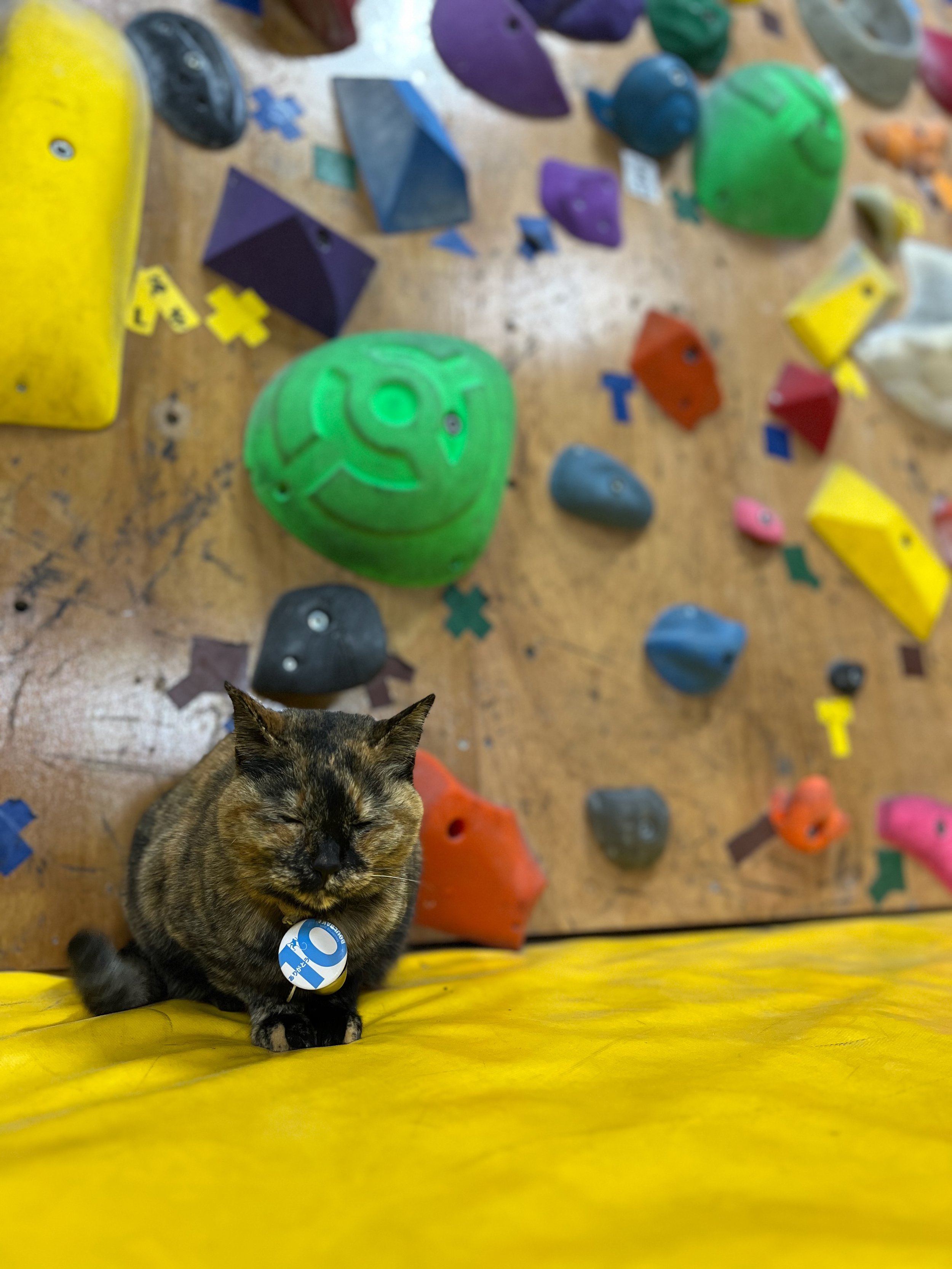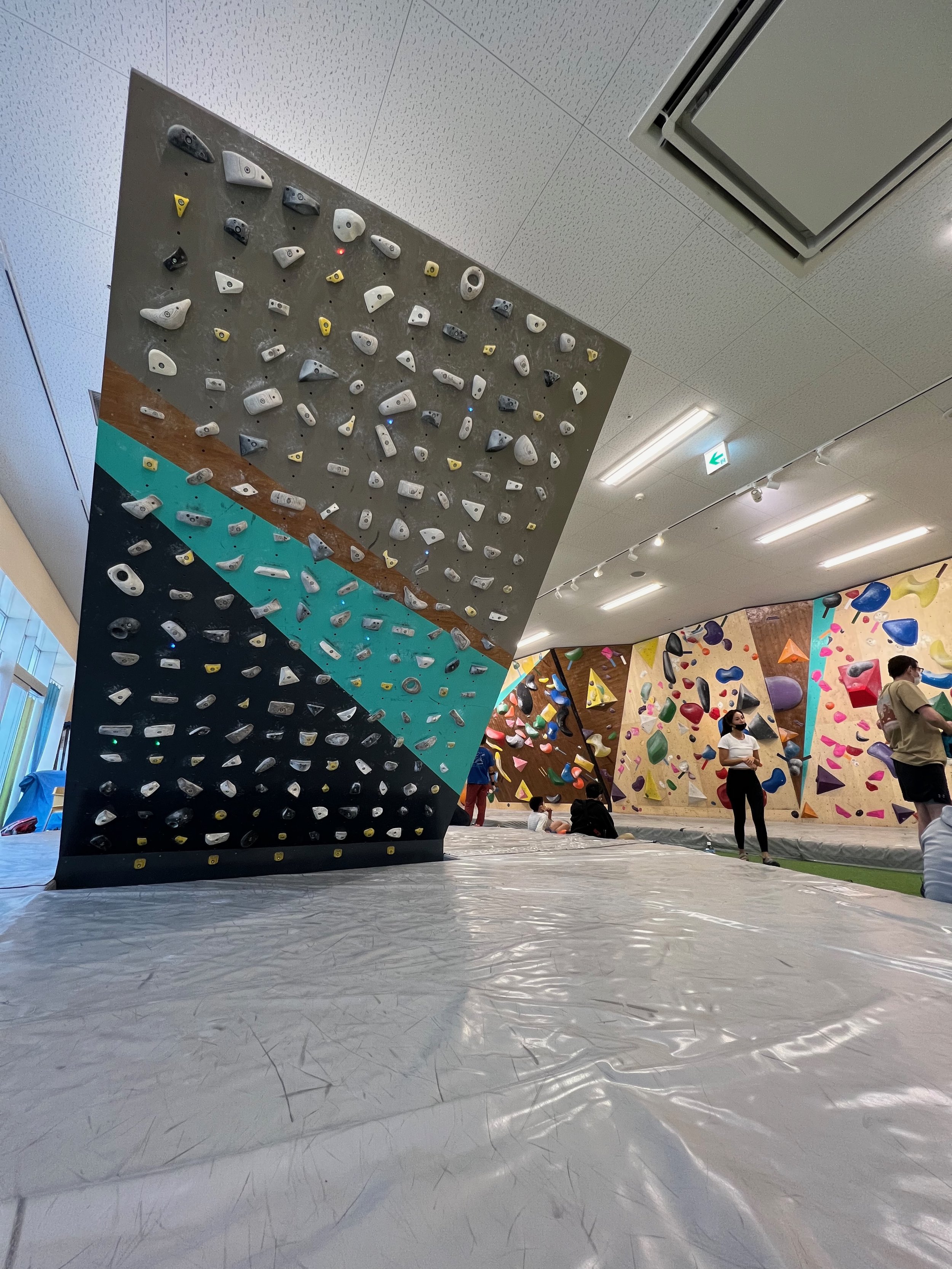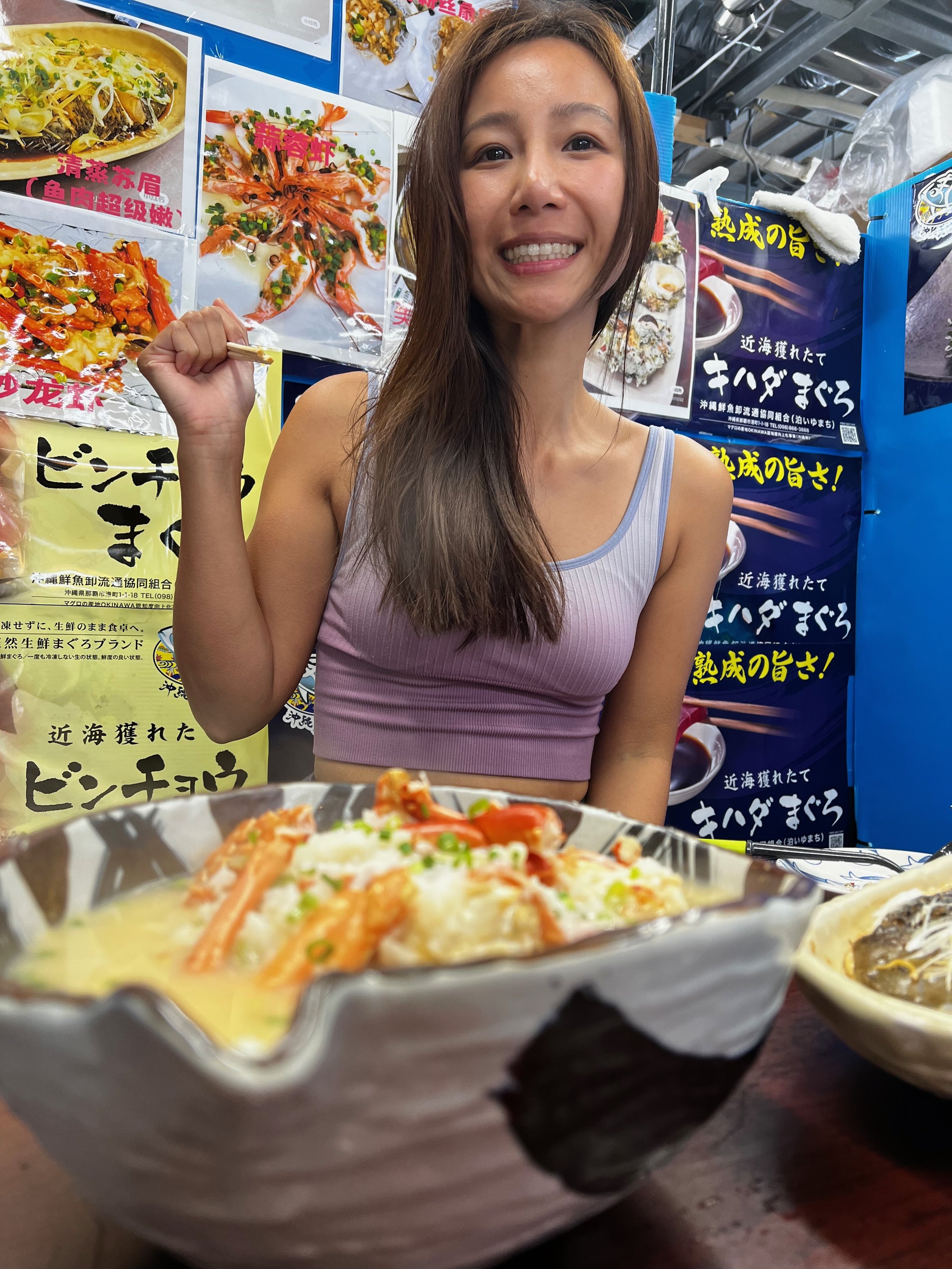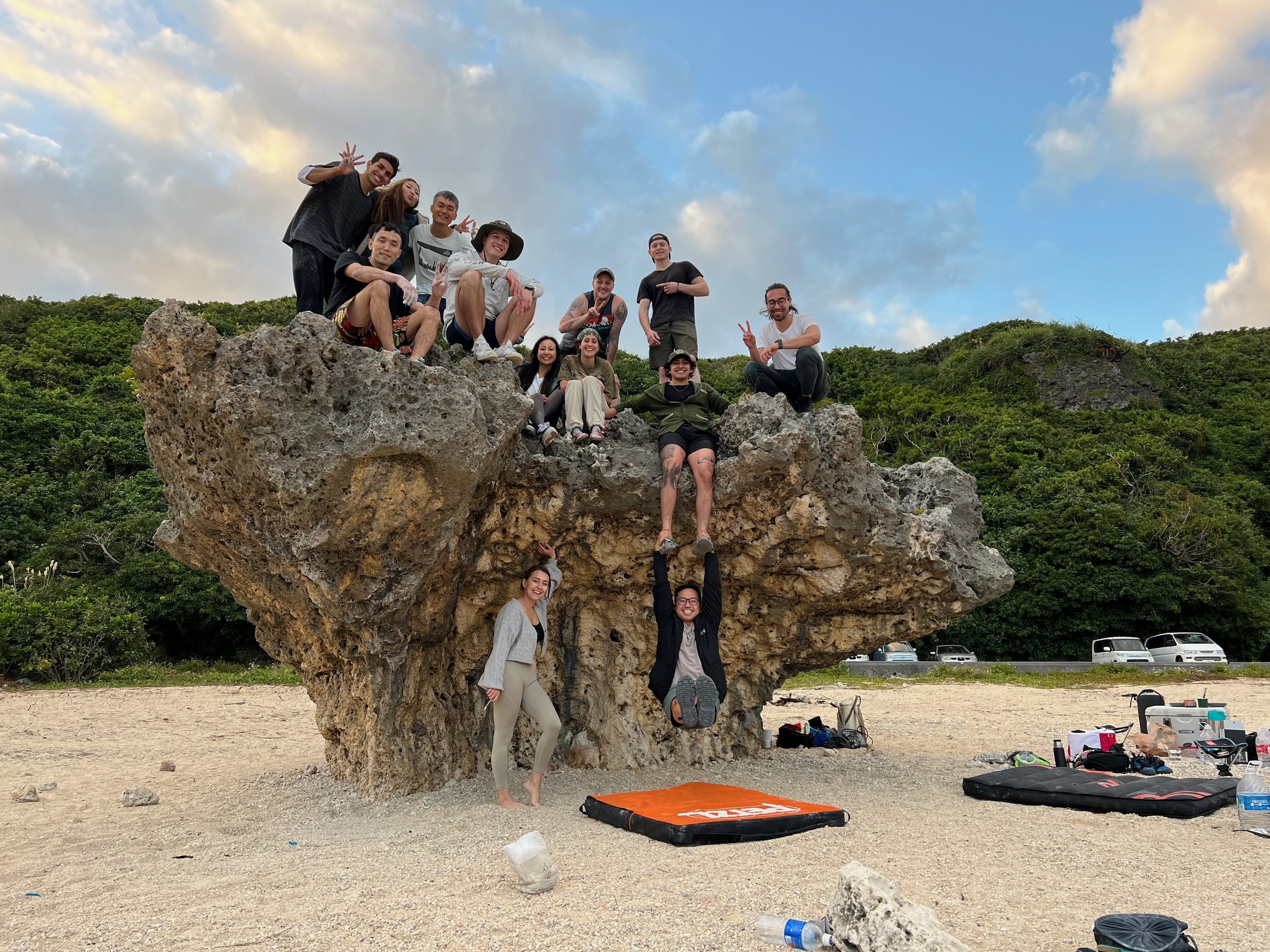Koh Tao: Granite Dreams and Sea Breezes
As the ferry makes its final approach, Koh Tao rises from the turquoise sea — a jungle-covered island scattered with massive granite boulders. Most people on board are here to dive, but I’ve got climbing shoes hanging from my backpack and a different plan. The moment I step off the boat, the island greets me with a warm, humid breeze laced with salt, Thai spice, and a hint of weed. I’ve just arrived, and already I feel the energy — the stoke to start exploring the vibe, rock and sea.
Where Granite Meets the Sea
Thailand is known for towering limestone walls in places like Krabi and Chiang Mai — but Koh Tao offers something different. A granite island with a laid-back vibe, it’s perfect for beginner to Advanced climbers looking to escape the crowds and climb in paradise.
Climbing here started just a couple of decades ago. Since then, over 150 sport and 200+ boulders have been established. Goodtime Adventures led the early development, but today it’s the Koh Tao Climbing Club that keeps the scene alive — maintaining and establishing routes, hosting meetups, and building community.
The granite here is rough and characterful — sharp, grippy, and more varied than you’d expect. While Koh Tao is known for its slabs and face climbs, there are also a surprising number of steeper lines and offwidth cracks. The rock demands good footwork, but rewards it with satisfying movement and unforgettable settings. Most popular routes are now bolted with titanium, built to withstand the salty air and humid conditions.








Where to climb on Koh Tao?
Most of Koh Tao’s granite climbing is concentrated in a handful of crags, with routes suited for beginner, intermediate, and expert climbers. All areas are within easy reach by scooter from anywhere on the island.
Golden View is the most complete crag on Koh Tao — and the heart of the local climbing scene. Perched high in the hills, it offers panoramic view of the Island and offers everything from beginner-friendly slabs to more technical face climbs. With both sun and shade depending on the time of day, it’s climbable any time of the day.
Lang Khai (Lost Faces) is located on the island’s east coast and features some of the most spectacular ocean-view climbing. The approach is short (15min), the atmosphere is salty, and the climbing is ideal for beginners to intermediate climbers.
Temple Rock has fewer routes, but it’s a must for intermediate to advanced climbers. The granite is sharper, the lines more technical, and it’s home to some of the hardest climbs on the island — all tucked away behind the temple.
Other crags like Jansom Bay and Mek’s Mountain also offer solid climbing, but we don’t actively promote them due to access issues — including entrance fees on private land without any support for climbers or route maintenance. We encourage visitors to support crags that are maintained, and backed by the community, especially those where climbers have worked with locals to ensure respectful, long-term access.
Find Your Project
-
-
Koh Tao has no shortage of granite gems for intermediate climbers. Here are some of the most beautiful lines for you to try.
🌄 Golden View
★★★ Do It!, 6b+
A Golden View classic with sustained face climbing and playful sequences.
★★☆ Tilikum’s Revenge, 6b+
This one flows beautifully along a natural line. Expect balancey positions, small feet, and a few powerful pulls.
★★☆ The Edge, 6a+
It kicks off with a slabby start before dancing up a sharp arête finish, where precision footwork and trust are key.
🌊 Lang Khai (Lost Faces)
★★★ Petrichor, 6a+
A must-do at Lost Faces. Expect fluid movement, solid footwork, and just the right amount of challenge — all framed by epic ocean views.
🏝 Jansom Bay
★★★ Leg Day, 6a
A picture-perfect off-width that delivers more than just a pump — it’s also the most photogenic route at the bay. Iconic and unmissable.
-
There are endless routes to try on Koh Tao, but here are some of the island’s best advanced lines to add to your ticklist.
🌄 Golden View
★★★ Titan, 6c+
A stunning arete climb made for golden hour. Technical footwork leads into a leaning crux sequence — top out just in time for the sunset.
★★★ Whale of a Time, 7a
Classic Koh Tao granite: delicate slab climbing, razor crimps, and plenty of foot trust. Rewarding and exposed.
🏝 Jansom Bay
★★★ Trauma Extension, 7a+
The second pitch of Grunt Force. A short but powerful line — bring tape or toughen up. A proper fight in paradise.
★★★ Blood Donor, 6c+
Starts mellow, finishes wild. Expect a pumpy overhanging crack with sharp holds that live up to the name.
🌊 Lang Khai (Lost Faces)
★★☆ Plastic Tokay, 6c
A techy line with a sneaky dyno that keeps even confident climbers guessing. Beautiful setting and great movement on clean granite.
-
As an expert climber, Koh Tao opens up fully. You’ll find powerful lines, technical granite puzzles, and maybe even bag a first ascent on one of the island’s open projects.
🌄 Golden View
★★☆ Kun Poo, 7b
A punchy Golden View classic with steep movement and exposed position. Powerful and rewarding.
☆☆☆ Kun Touat Project, 7c+ / 8a
Currently the hardest line at Golden View — still open. Bring your A-game and maybe your name will be the first in the logbook.
🛕 Temple Rock
★★☆ The Monk, 7b
A compact jungle testpiece. Sharp, technical granite with thoughtful sequences. Feels full value for the grade.
★★★ El Templo, 7c
One of Koh Tao’s hardest climbs. Small crimps, big commitment — a true granite crux-fest hidden in the trees.
Climbing Rules & Community Responsibility
Always follow local regulations, practice Leave No Trace principles, and respect the routes, crags, and natural surroundings. Climbing is inherently risky, so it’s crucial to take ownership of your safety and the decisions you make on the rock. Learn more at Koh Tao Climbing Club.
Off the Wall
Did you find your project? Great! If not, no worries—there’s so much more to Okinawa than just epic climbs. In this section, we dive deep into what makes this island a true paradise beyond the crags. From savoring mouthwatering local dishes like Okinawa soba and Mozuku tempura, to discovering hidden beaches, cultural landmarks, and the best places to unwind after a tough session on the rock, we’ve got you covered.
Rest Day activities
xx
Diving
xx
Snorkling
xx
Trapetz
Fxx
Where to Eat?
One of the best parts about climbing in Okinawa is the reward waiting for you at the end of the day—Okinawa’s food. After spending hours on sharp limestone cliffs, nothing beats sitting down to a meal of Fuu Champuru, Okinawa soba, or Umibudo. The island’s food is as unique as its culture, blending Japanese, Chinese, and Southeast Asian influences into dishes you won’t find anywhere else.
Kunigami Minato Shokudo - $
If you’re looking for proper homestyle Japanese food after a day of climbing at Cape Hedo or Zatsun Tunnel, Kunigami Minato Shokudo is the spot. The simple yet satisfying combo of rice, grilled fish, miso soup, and pickles hits the spot perfectly after a long day on the rock. Conveniently located on the way back from the crags, it’s a great stop to refuel and relax. Just make sure to check their hours—don’t climb too late, or you might miss this local gem!
Tomari Iyumachi Fish Market - $$
I had some of the best sashimi of my life at Tomari Iyumachi Fish Market in Naha. If you arrive in the morning, you can watch the fish being freshly prepared right in front of you—it’s an incredible experience. The market is packed with stalls offering everything from raw sashimi to seafood they can cook for you in any style you like. You can even grab some takeaway and enjoy it at the nearby beach.
Yukino - $
The Best Okinawan Food I’ve Ever Had! After living in Okinawa for around six months, I can confidently say that Yukino in Nago serves the best Okinawan food I’ve tasted. The menu is a showcase of the island’s flavors—everything from the savory Fuu Champuru and tender Rafute to the refreshing Okinawa soba and unique Mozuku tempura. Don’t miss the Umibudo and Shimadofu, either; it’s the perfect balance of salty and fresh. Make sure to come early or book in advance, as it’s a local favorite and fills up quickly. Best of all, Yukino offers some of the most value-for-money meals you’ll find in Okinawa. It is the perfect detour after climbing in Cape Hedo, Zatsun or Katsuyama.
What to see?
Need a break from climbing? Nago has the perfect combination of adventure and relaxation for your rest day or discover the Southern part of Okinawa with a mix of adventure, history, and the perfect spot to unwind.
Okinawa Churaumi Aquarium: Meet the Giants and Cutest Creatures of the Ocean.
No trip to Okinawa is complete without a visit to the Okinawa Churaumi Aquarium, one of the largest and most impressive aquariums in the world. As you explore the exhibits, you’ll get up close with a wide variety of marine life, including some of the island’s cutest residents—like the adorable puffer fish and playful baby eels. The real showstopper, though, is the aquarium’s massive whale shark—the largest fish in the world—gliding gracefully through the enormous Kuroshio Sea Tank. It’s a sight that will leave you in awe. Whether you’re a marine life enthusiast or just looking for a fun, relaxing day, the Churaumi Aquarium offers a fascinating peek into Okinawa’s underwater world.
Sesoko Beach: Relax, Boulder, and Carb Load Like a Champ
Sesoko Beach is the perfect place to kick back and relax after a day of exploring. Picture this: soft white sand, crystal-clear water, and the sound of waves crashing. But let’s be honest, you probably won’t be able to resist trying out some of the bouldering that Okinawa has to offer nearby. Once you’ve had your fill of climbing, treat yourself to something delicious—either head to Pizza in the Sky for some pizza with a view or grab a burger at Captain Kangaroo on the way back. It’s the ideal beach day with a little adventure thrown in!
Climb, Snorkel, Explore History, and Catch a Sunset
Start your day at Hanagusuku Beach, where you can snorkel in wave free enviroment during the low-tides and then challenge yourself with some bouldering at nearby Gushichan Beach—a perfect combo of underwater exploration and seaside climbing. After your active morning, dive into Okinawa’s history at the Peace Memorial Park, a meaningful stop to learn about the island’s past. To end the day, head to Umikaji Terrace Senagajima for a well-deserved drink, watch the sunset, and catch planes taking off from the nearby airport. It’s the perfect mix of adventure, culture, and relaxation.
How to get around?
The best and only way to explore Okinawa, especially if you’re planning to hit the crags and hidden beaches, is by car. Public transportation on the island is limited and doesn’t reach many of the climbing spots or remote areas, so renting a car is highly recommended for convenience and flexibility.
For a hassle-free experience, I recommend ABC Rental Car at Naha Airport. They offer a convenient pickup service, making it easy to get your car as soon as you land. Whether you need a car for a day, a week, or even a month, ABC Rental has fair and competitive pricing options. Okinawa’s roads are well-maintained and easy to navigate, but keep in mind that driving is on the left side (like in the UK and Japan mainland).
A big thank
I really want to just give a huge credit to Dylan for all the vouteer work he does in running the Koh Tao Climbing Club. Without him climbing on Koh tao would never been as enjoyable, the club fridays that he arranges together with his partner Clara, makes it such a vibrant place. Serval of pictures selected for this Blog has also been taken by him.
Did You Like the Blog?
If you enjoyed reading and want to help us keep exploring and sharing more beautiful climbing destinations, consider supporting us. Every little bit helps us cover website maintenance, travel expenses, and the time it takes to create these guides.































